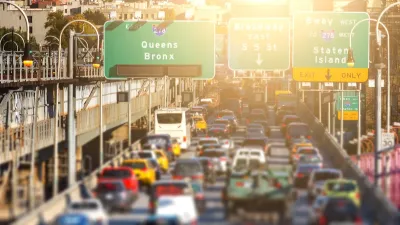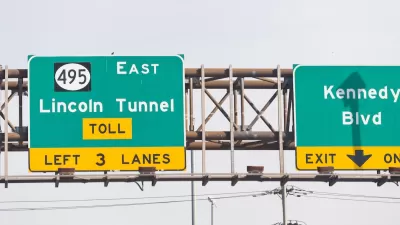Improved transit service could make a major difference in how the program is received by New Yorkers.

“Few good ideas have been resisted as loudly as New York’s plan to charge a toll to drivers entering Manhattan ($15 for most) and use the money to improve public transit,” writes Liza Featherstone in The New Republic.
Although New York’s policy does still have flaws that must be fixed—insufficient exemptions for low-income drivers, for instance—the populist argument against congestion pricing is mostly disingenuous. Only 4 percent of outer-borough New Yorkers drive to Manhattan to work; 57 percent take public transit. And only 2 percent of low-income outer-borough New Yorkers, specifically, would be asked to pay a congestion fee as part of their commute; 61 percent take public transit.
For the policy to gain and maintain public support, Featherstone writes that a large number of New Yorkers must experience its benefits quickly — meaning, better transit service and reduced congestion. “Public transit is one of the least abstract political issues for New Yorkers, affecting where we can work, whether we can get there in time, and whether we can pick up our kids on time at the end of the day.” This is why, Featherstone writes, the ‘Get Congestion Pricing Right’ proposal from Assemblyman Zohran Mamdani, which calls for making an additional 15 bus routes free and increasing bus frequency, could make the difference in how the program is received.
FULL STORY: How to Fix New York City’s Latest Controversial Policy

Manufactured Crisis: Losing the Nation’s Largest Source of Unsubsidized Affordable Housing
Manufactured housing communities have long been an affordable housing option for millions of people living in the U.S., but that affordability is disappearing rapidly. How did we get here?

Americans May Be Stuck — But Why?
Americans are moving a lot less than they once did, and that is a problem. While Yoni Applebaum, in his highly-publicized article Stuck, gets the reasons badly wrong, it's still important to ask: why are we moving so much less than before?

Research Shows More Roads = More Driving
A national study shows, once again, that increasing road supply induces additional vehicle travel, particularly over the long run.

Minneapolis Bans Rent-Setting Software
Four cities have enacted restrictions on algorithmic software that can inflate rent costs.

Oakland to Add 244 New EV Chargers
Oakland plans to launch its new charging network at eight locations by the end of 2025.

Jane Goodall Inspires with Message of Hope, Resilience, and Environmental Action
Speaking in Pasadena, Jane Goodall offered a hopeful and inspirational message, urging global compassion, environmental responsibility, and the power of individual action to shape a better future.
Urban Design for Planners 1: Software Tools
This six-course series explores essential urban design concepts using open source software and equips planners with the tools they need to participate fully in the urban design process.
Planning for Universal Design
Learn the tools for implementing Universal Design in planning regulations.
Heyer Gruel & Associates PA
City of Moreno Valley
Institute for Housing and Urban Development Studies (IHS)
City of Grandview
Harvard GSD Executive Education
NYU Wagner Graduate School of Public Service
City of Cambridge, Maryland
Newport County Development Council: Connect Greater Newport





























